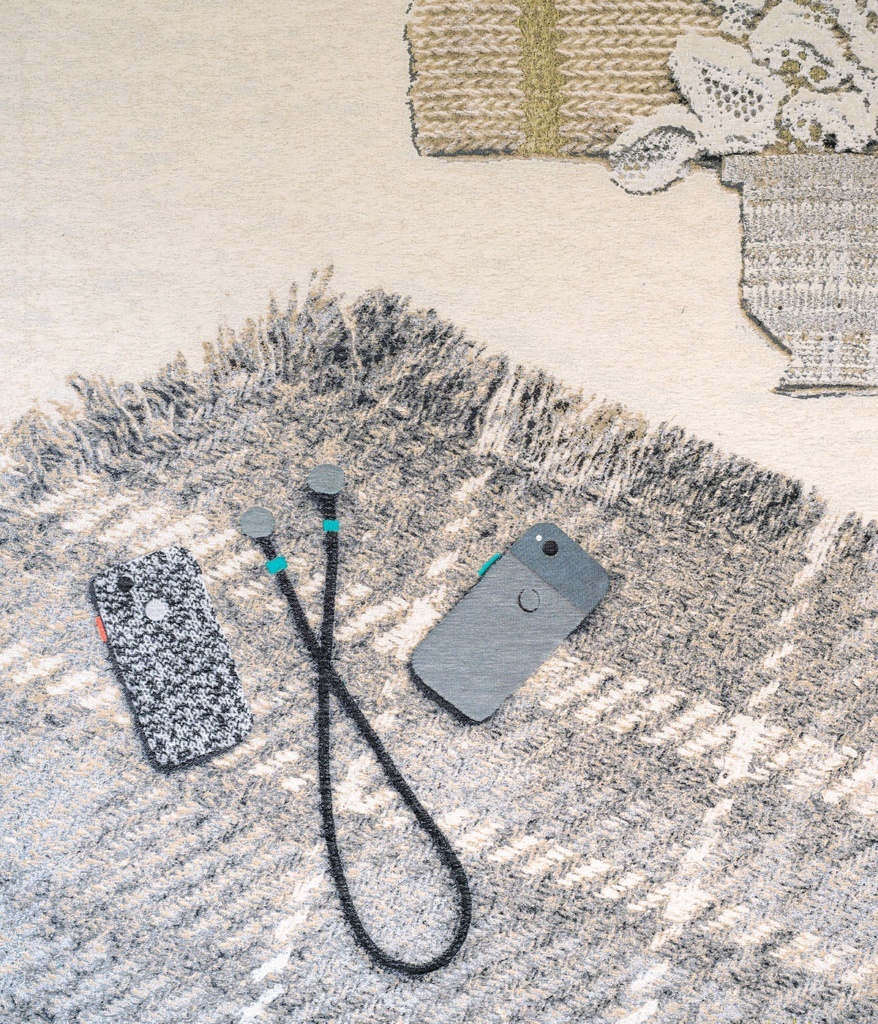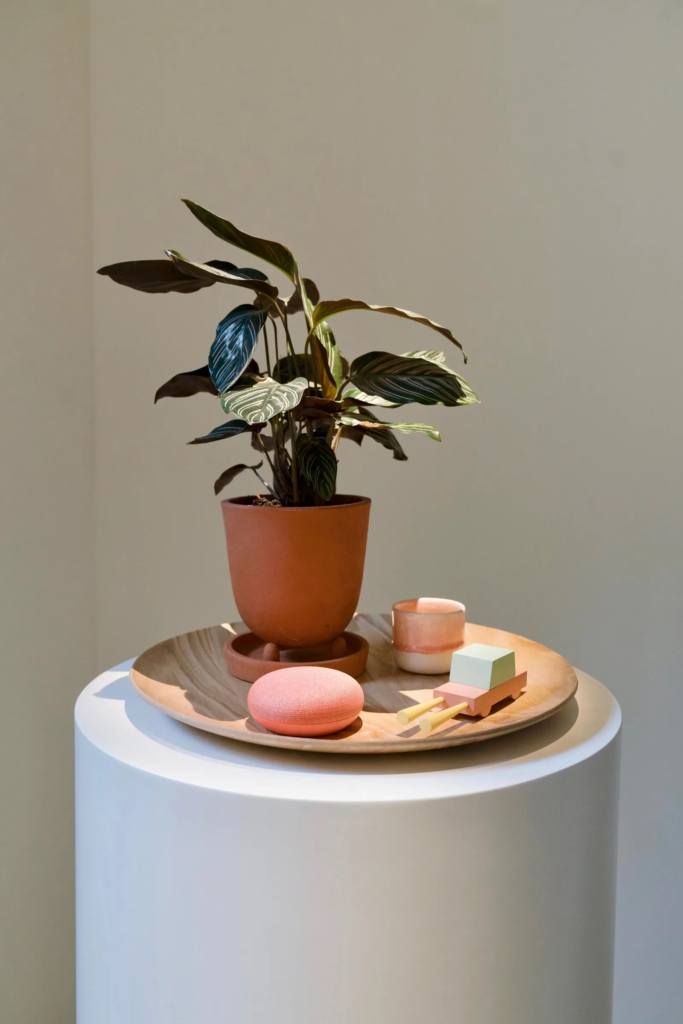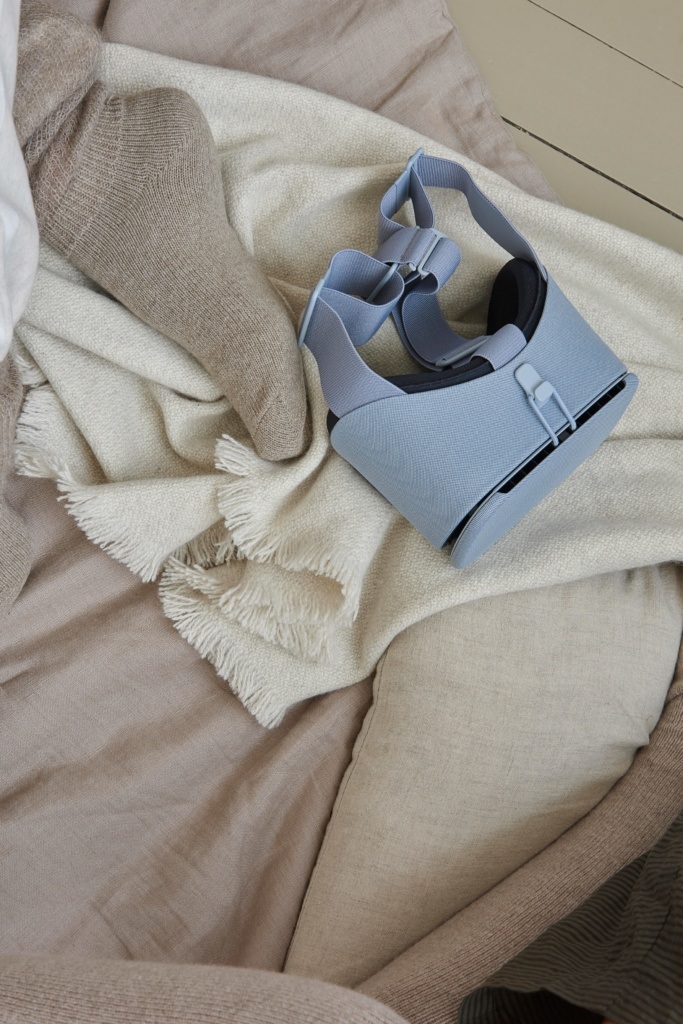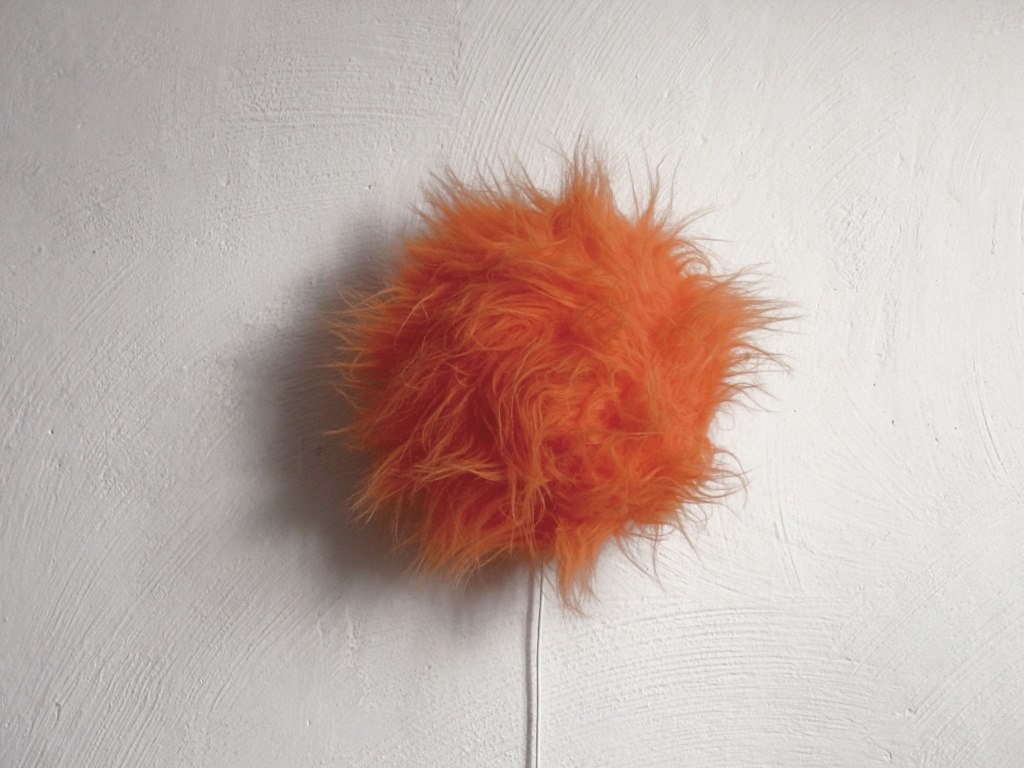Let’s begin, predictably, with an Apple product video. The ad opens on a dark screen, pebbled with stars. As the music swells, our vision pans over a backlit curve — a planet, presumably, as depicted in just about every cinematic space opera — and then the curve reveals itself as a human head, cradled by a large set of headphones. AirPods Max have arrived, unruly product name and all. (They cost $550, and so far the reviews are mixed.)
In an ad like this, one expects “the glint,” the fleeting, digitally-produced flash of light across a smooth surface that Hank Gerba describes in his recent essay, a digital manipulation conjured in “an effort to market a certain kind of immediacy in our interaction with consumer technology.” The glint highlights the physical qualities of the screen on which it is displayed — hard, shiny, sleek, ready to be lit up with sparking evanescence. However, as the Apple headphones come into clear view under an artificial sunrise, the camera takes us flying toward ear cushions covered in a plush, acoustically optimized knit; then skims across the curves of the warp-knit headband, a fantastically knobbed and taut landscape, like Luke through the trenches of the Death Star. The headpiece of the AirPod is matte rather than shiny, and the light blasts through the listener’s tightly shorn hair in a hazy halo. It’s immediately evident that this is a narrative not about smoothness but about texture: yielding, fuzzy, tactile.
In the ad, a curved ceramic mug echoes the rounded side of the smart speaker, a finger strokes a sheepskin rug, another finger strokes a touchscreen
“We choose genuine soft fabrics that are made to be worn,” explained Apple industrial designer Eugene Whang, “rather than fake materials such as vinyl or artificial leather.” Some commentators expressed surprise at the choice of woven textiles for the ear cups, where a more conventionally high-end finish like fine grain leather might be expected. But Apple’s highly engineered knits seem controllable and aesthetically precise in a way that leather could never be. Watching the video, with its moments of gleaming technological perfection colliding with fuzzy sweaters and strands of backlit hair, it’s clear that textiles are being called on to perform some important ideological work.
The embrace of textiles and soft textures isn’t confined to the Apple cinematic universe. Across the product ranges of the big tech hardware makers, especially those making smart home devices, designers are increasingly turning to fiber and cloth. Google’s 2018 installation at Milan Design Week, Softwear, presented a series of rooms featuring staged interior vignettes full of soft but minimal Scandinavian furniture, throw blankets, and hand-hewn bric a brac. Among the armchairs and Montessori blocks were scattered Google Home devices, Pixel phones, and smart speakers. Organic, industrial, technical, textural, all seamlessly compiled in this domestic fantasia.
“We are in front of flat shiny things all of the time,” said Ivy Ross, Google’s vice president of hardware design, at a preview for its 2017 hardware launch. “We wanted to make technology a little more human by putting soft curves on everything.” Since her arrival in 2014, Ross has brought in a design approach centering hominess and tactility, often integrating textiles into a growing array of hardware and, in particular, home devices. “We wanted Home Mini to be like snow had fallen on the form,” she says in a beguiling brand video, which shows fibers woven on an automated loom, yardage sluicing through a rinse cycle with the aid of burly-armed men, and industrial designers pensively rubbing fabric swatches. “My team’s job is to figure out what it feels like to hold Google in your hand.”

The upswing in textiles as a component of tech devices is coincident with the growth of smart home devices as a product category. As technology makers work to ensure internet-connected objects become a ubiquitous presence in domestic spaces, it is essential that these things feel approachable and comforting. “The home is a special intimate place, and people are very selective about what they welcome into it,” says Isabelle Olsson, lead designer for Google Home hardware. The Home Mini’s river-rock cuteness is a supposed antithesis to the “black plastic, complicated buttons, and random blinking lights” of other, less desirable tech devices. In their intimate forgettability, Home Mini and its textured compatriots shoot for a sort of techno-cozyness, a hygge modernism for the contemporary family.
To be “very selective” about what you welcome into the home means employing home safety systems like Google’s Nest family of security cameras and smoke detectors, and rejecting intruders from the outside. These objects — made to be touched, desperate to be at home in your house and in your pocket — deploy textiles as domestic camouflage. A SimpliSafe home security ad, titled “The Feeling of Hygge,” pounds the point home. The commercial opens on an attractive, flaxen-haired family lounging among throw blankets and candles, wearing Nordic sweaters and woolen socks, as an unassuming security device (not fabric covered, but the point remains) glows reassuringly nearby. Technology is perfectly integrated and all is comfy, protected and sheltered against the night outside (which is dark and full of terrors). The images in the ad are eerily reminiscent of Google’s Softwear installation — a curved ceramic mug echoes the rounded side of the smart speaker, a finger strokes a sheepskin rug, another finger strokes a touchscreen. With SimpliSafe, we are told, “not only is your beautiful family protected, so is your sense of design.”
The soothing, tactile appeal of textile-wrapped home devices offers a very different vision from the tech products that preceded them. Google’s earlier foray into hardware with devices like Google Glass epitomized a kind of awkward science fiction. Google Glass gave us the AR glasses and smart contact lenses imagined in films from Terminator to Mission Impossible, manifested in reality as dork-core rectangles that pegged wearers as conspicuous early adopters or techie scum, depending on your perspective. Before its 2018 HomePod smart speaker, Apple’s product line was dominated by seductively sleek and seamless plastic and steel forms, sometimes alien and sometimes biomorphic, but always tending toward gleaming fetishistic finishes. These and other devices gestured toward a future of cyborg connectivity and seamless integration with technology, where we might become one with our tech by implanting it, wearing it, nestling it into our ear canals and around our wrists.

Why the move, from smooth surfaces and cybernetic cool, to warm fibers and domestic textures? Textiles and fabrics don’t meld with the body. They come into intimate contact with us, clothing, draping, and swaddling, but instead of taking on our form they surround us and protect us from the outside world. They lend these qualities — homeliness, warmth, security — to the tech objects they now swaddle. The malleable, shape-shifting nature of textiles makes them the ideal clothing for a device that is trying to insinuate itself into the home.
The description of tech-enabled safety in SimpliSafe’s seductive marketing belies the fact that perhaps you’ve already let the intruder worm its way inside, a wolf in hyggelig clothing. The smart speaker brings surveillance capability into the house, and that surveillance goes both ways. Snippets of your conversation are ferried back and forth as they’re run through speech recognition and natural language processing software. Information about thermostat temperatures, lighting use, and other activity is tallied and aggregated. These digital sentries can help you spot potential intruders or surveil the delivery guy as he drops off your packages, but they’re also delivering packages of information back to base at Google or Amazon. A computer is a rock that we’ve tricked into thinking; Google Home Mini is a rock we’ve been tricked into forgetting is a computer.

Google Home Mini and its cohort are that rare class of digital object: a gadget unencumbered by a preexisting form. It must have a speaker, and it must have electronic innards, but unlike a smart fridge (fridge shaped) or a smart lightbulb (lightbulb shaped), the smart home speaker is an object without qualities. How do we imagine omnipresent technology; how do we imagine computing environments without computer interfaces? It’s an open question, full of possibility. In their recent paper “More work for Big Mother,” Jathan Sadowski, Yolande Strengers, and Jenny Kennedy walk through a short history of smart homes, from Disneyland’s Monsanto House of the Future to The Jetsons. Each example proposes some version of domestic technology as easeful and seamless, with the technology itself just a facilitator of enhanced everyday life. The smart home, the authors write, “is an ingenious way of installing the infrastructure of digital capitalism in the private places that are hardest to reach.” It follows that the formal ambiguity of the smart home speaker is a useful adaptation, allowing its appearance to blend into the furnishings, to go unseen.
Google, SimpliSafe, and other networked homeware purveyors seem to suggest that we can afford to be cozy because we’re watched over by benevolent machines. The technological aura that infuses the smart home becomes a key element of its hygge-ness, imbuing every room and throw blanket with a kind of free-floating potential, alive and special. Spike Jonze’s 2013 film Her presents us with just such a warm, textile vision of technology and domestic space. The Joaquin Phoenix character works in an office full of dust-moted beams of light and wood grained computer enclosures, and lives in a home of blond wood, soft sofas, and embedded technology. Costume designer Casey Storm describes this as a conscious piece of worldbuilding. “In the future, one has access to everything. Why wouldn’t we create a world that is warm and cozy and soothing? Why wouldn’t we gravitate towards colors and fabrics and textures that made us feel comfortable and loved?” Although the world of Her has smartphones and computer screens, the production design succeeds in making the entire mise-en-scene appear permeated with technological potential and comforting tactility, simultaneously.
In this environment of wistful domestic smart-ness, where computers can be soft and anything can be a computer, it’s no real surprise to see textiles enlisted as a literal space of computation. Why shouldn’t the fabrics themselves become smart? Not just smart as in technical, although plenty of technology is required to design ripstop fiber and goretex and performance wicking. No — smart as in alive with information, signals pinging across warp and weft, the woven strands conveying data around the garment or off into the air. Today, smart textile startups are proliferating, with companies embedding sensors in garments or, more ambitiously, weaving capacitive fibers into the fabric itself. Google’s smart fabric initiative, named Project Jacquard after the famous loom builder (whose punch-card operated, automated looms were an early precursor to modern computing technology), weaves conductive threads into jacket cuffs and backpack straps, allowing touch gestures like a swipe, tap, or stroke of the fabric to be translated into commands sent to the user’s phone via bluetooth. This, says project founder Ivan Poupyrev, is a first step towards “making computers and computing invisibly integrated into objects, materials, and clothing.”
A computer is a rock that we’ve tricked into thinking; Google Home Mini is a rock we’ve been tricked into forgetting is a computer
The fantasy is that fabric might be a network, transmitting data in the same way it transmits warmth to a wearer and soundwaves from a speaker. In the AirPods Max product video, the camera eye passes lovingly over the acoustically optimized knit of the ear pieces and the warp knit of the overhead canopy. It looks like a thousand interwoven fibre optic cables, knitted together in a network of light and engineering and responsiveness. One gets the sense that messages might be traveling along the strands.
Science fiction storytelling and science history are flush with smart textiles and attempts at networked fabrics. Murray Leinster’s 1945 novella First Contact describes an electronic device controller built into clothing, a textile button that can be pushed to open a communication link like a kind of woven-in walkie talkie. In A Scanner Darkly, Philip K. Dick turns smart fabric into surveillance evasion with the scramble suit, a “superthin shroud-like membrane” which scrambles the wearer’s physical form and renders them effectively unseeable. More recently, in Marvel’s Black Panther, T’Challa wears a Wakandan version of smart fabric. His panther suit is woven with Vibranium, the superstrong metal that absorbs, stores, and releases kinetic energy, bestowing its wearer with superhuman abilities. In the 2018 film version, teen tech genius Shuri demonstrates the new suit along with a panoply of other advanced gadgets while wearing a form fitting dress with a 3D printed-looking wide weave net textile around the bodice and neckline.
In Black Panther, textiles are cultural heritage, technology, and futurity combined — holistically utopian, the vibranium fabrics are meant to integrate the past with the visionary future. A similar sort of message, stripped of any righteous connotation, can be read through Apple and Google’s marketing, which gestures toward the craft and history of textile production as a way to assuage our fears about unfamiliar surveillance technology, and put a familiar and comforting spin on the “smart” future.
As Project Jacquard hints, textiles and computation were woven together from the start. Beginning in the early 1700s, weavers and loom-builders devised punched paper card patterns that simplified the creation of complex woven designs (a process that was improved and popularized by Joseph Marie Jacquard in 1804). The rows of perforated punch cards acted as a type of “program” that described which rods would pick up which threads, and when strung together, they allowed for a high degree of automation in textile manufacture.
The consequent reduction in the amount of skilled labor required to produce textiles didn’t go unnoticed by workers, many of whom were bitterly opposed to the technology and “who saw in this migration of control a piece of their bodies literally being transferred to the machine,” as Manuel De Landa writes in War In The Age Of Intelligent Machines. From the beginning, computing was used to create fabric, discipline labor, and manage populations — textiles and biopolitics, bodies clothed and bodies counted.
Even before punch cards entered the picture, fabric was an ur-site for abstraction and alienation. “20 yards of linen = one coat” writes Marx, in a thousand different formulations, throughout Capital volume one. Human labor power “becomes value only in its congealed state, when embodied in the form of some object,” and for Marx, linen is an archetypal commodity and ideal example with which to lay out his concept of the value form. While most contemporary tailors would argue that 20 yards of linen is likely more than enough for five coats, the point remains. The transformation of flax into fiber into textile into commodity is a disappearing act, with the variability of plant matter and hard labor transmuted into something consistent, tradable, and covetable.
Google, SimpliSafe, and other networked homeware purveyors seem to suggest that we can afford to be cozy because we’re watched over by benevolent machines
The fabrics I’ve described, from the aggressively domestic soft grey piqué of Home Mini to the pristine acoustic weave of the AirPods Max ear cups, aren’t grown but rather “engineered,” far removed from the field or the spinning wheel. Google’s textiles are spun from “100 percent recycled plastic bottles” — that is, polyester — and Apple’s acoustic mesh is some undisclosed synthetic. These technical fibers, and the extreme level of craft we’re told goes into them, wrench fabric away from its ruddy and earthbound history. If the history of textiles is cotton, the plantation, the sweatshop, then tech fabric is precise, abstracted, lab-grown.
Textiles, in their contemporary use by tech companies, cloak and conceal the function of products where it’s prudent to do so, soothing fears about surveillance and covering ugly mechanisms in muted shades of soft gray cloth. At an even more basic level, these textiles erase their own history. The fabric’s makeup is often purposefully inscrutable — certainly not linen or silk or wool — appearing to be 3D printed or extruded rather than conventionally woven. Tech fabric brings us comfort, protection, and domesticity while stripping away the sweat and stench of raw materials, and the labor that’s implicated in the transformation of agricultural products to fine cloth, as well as in the products it encases. From the factory workers that help manufacture components and assemble the circuitry to the oil workers pumping up feedstock for plastics and fuel for transport, these processes are smoothed and clothed through the soft magic of fabric.
This transmutation — the congealing of labor into value, and the violence hidden within — is an unstable process. Peter Strickland’s 2018 film In Fabric provides one small example. In the film, we watch the commodity take murderous revenge in the form of a haunted red dress that passes through the hands of a number of owners and wreaks havoc on each of them. As Marxist horror podcasters Jon Greenaway and Ash Darrow note, “20 yards of linen = one red dress,” sold to unwitting buyers by mesmerizing and witchy shop clerks. The dress is described in ecstatic terms, with fingers shown caressing the fabric and the satiny folds draping lushly over the wearer’s curves, before the dress turns on its owners and causes them to break out in a rash, destroying their appliances, and upending their lives. At the film’s surreal climax, we see a succession of people huddled over sewing machines in a workroom at the back of the store. Each is hooked to a thin IV tube that draws blood from their vein, which snakes around and threads through the machine to be sewn into the crimson fabric. In Fabric’s commodity is the literal blood of the workers, alienated labor congealed into a haunted dress and sent out to enact retributive violence.
Smart fabrics and the luscious textiles that cover smart home assistants are, if anything, doubly alienated. After the transition of raw material and labor to commodity, the fibers are embedded with sensors or draped over internet-connected speakers, far removed from their earlier function as a cloth that warms and protects, connected to global systems of data collection and capital. What repressed horrors might bubble and reemerge with these strange new fabrics? What animating forces might be smuggled beneath the light-dappled cloth? Perhaps it’s just cloth. But with cloth comes a long history of labor, industry, computation, commodity fetishism, and fantasy. It’s never just cloth.
